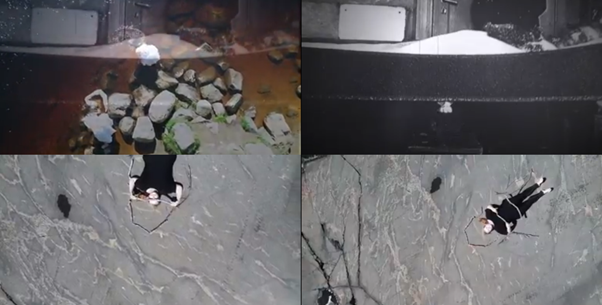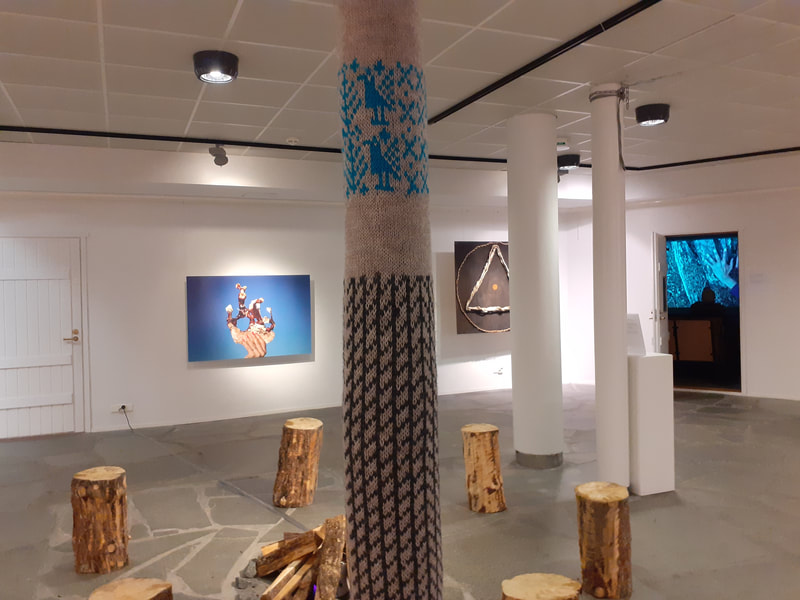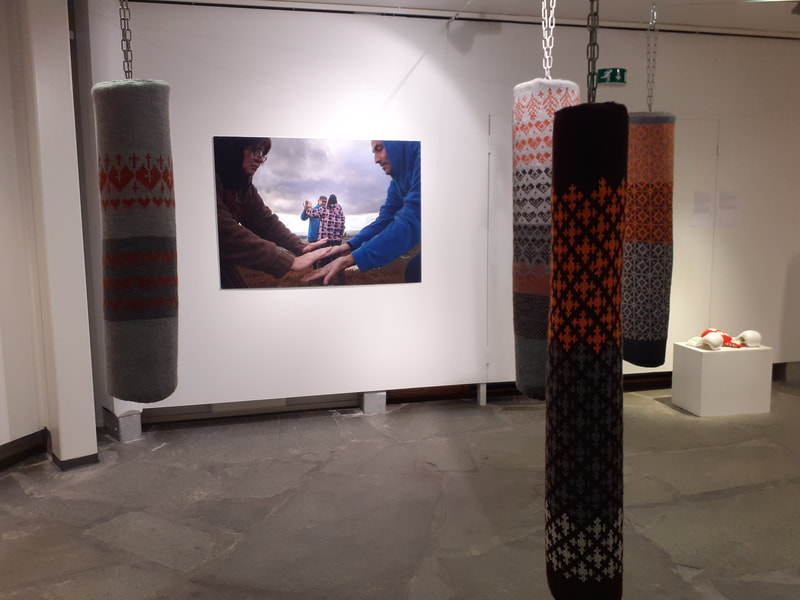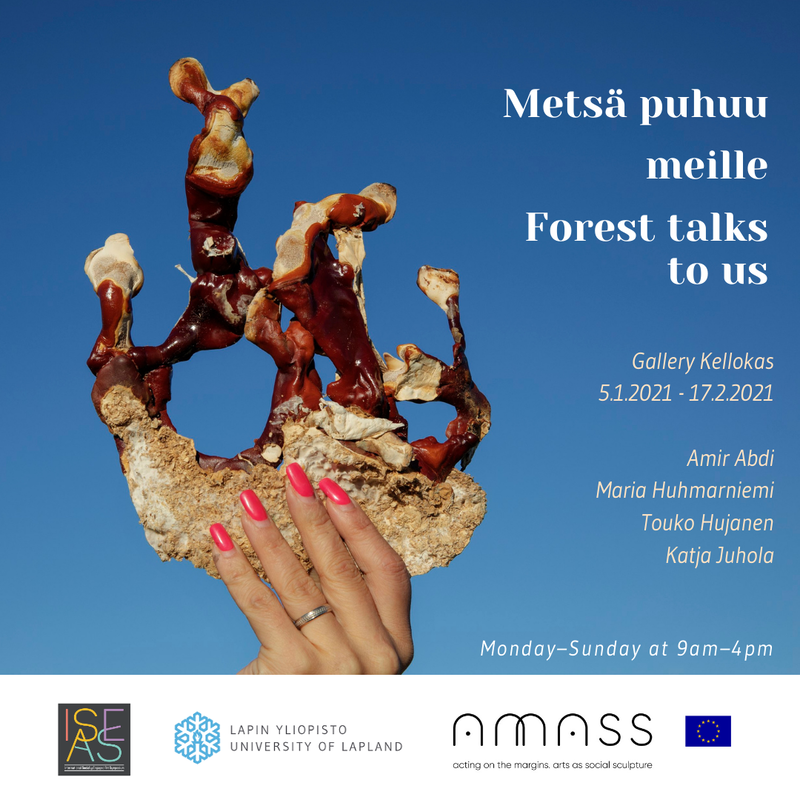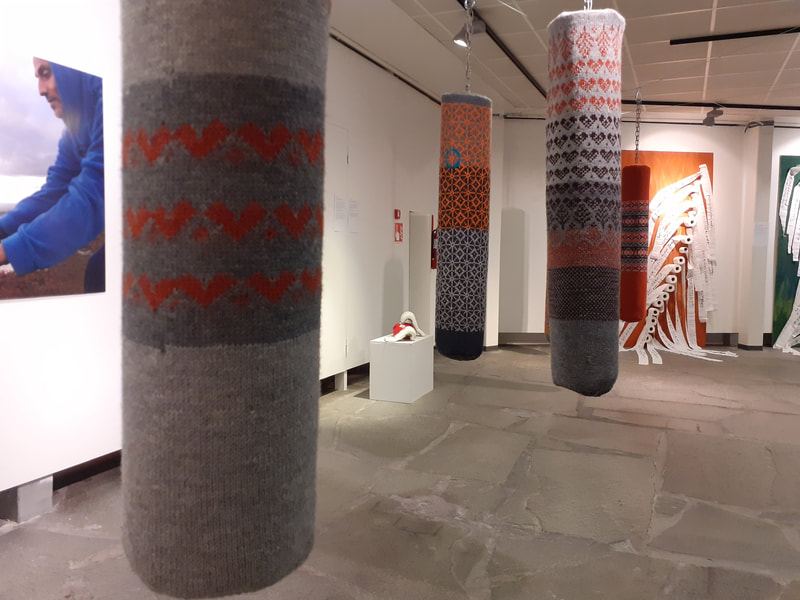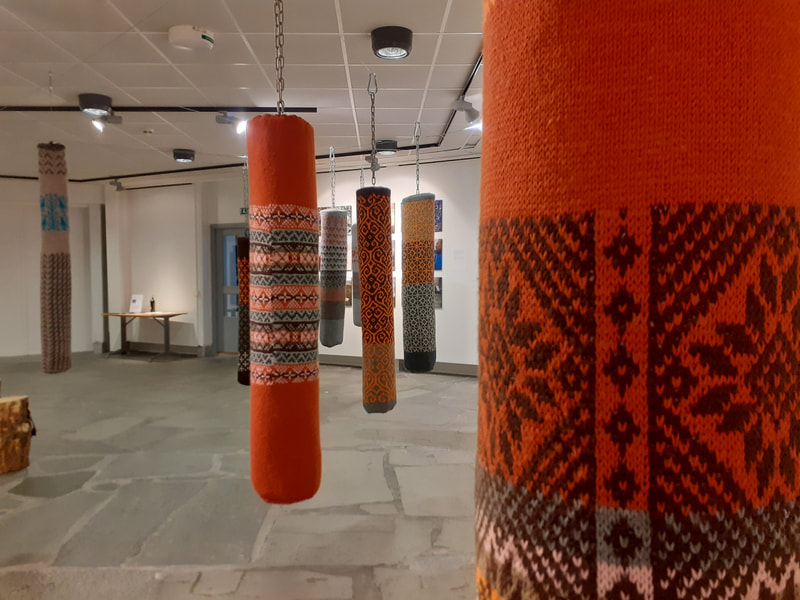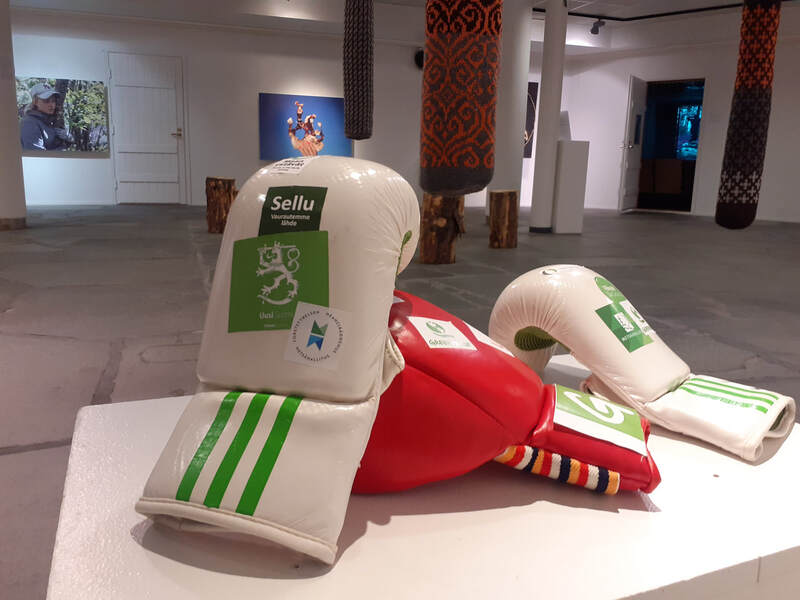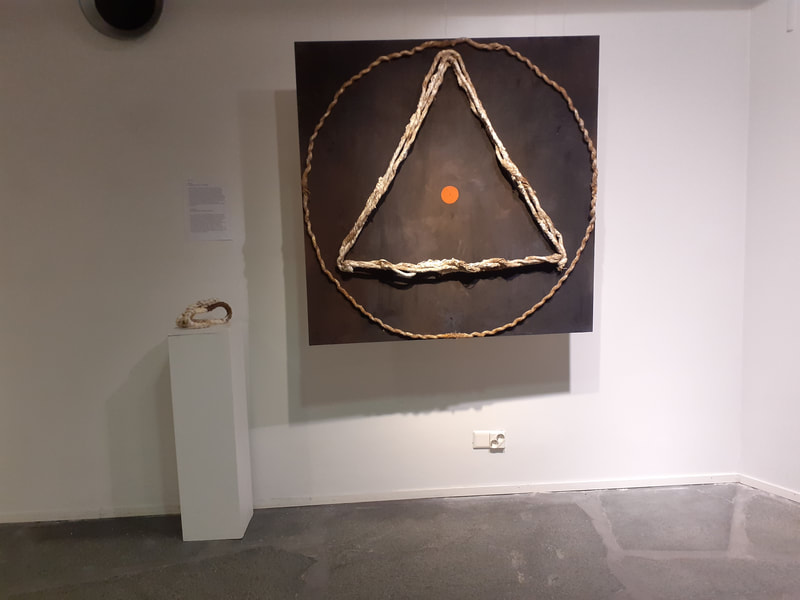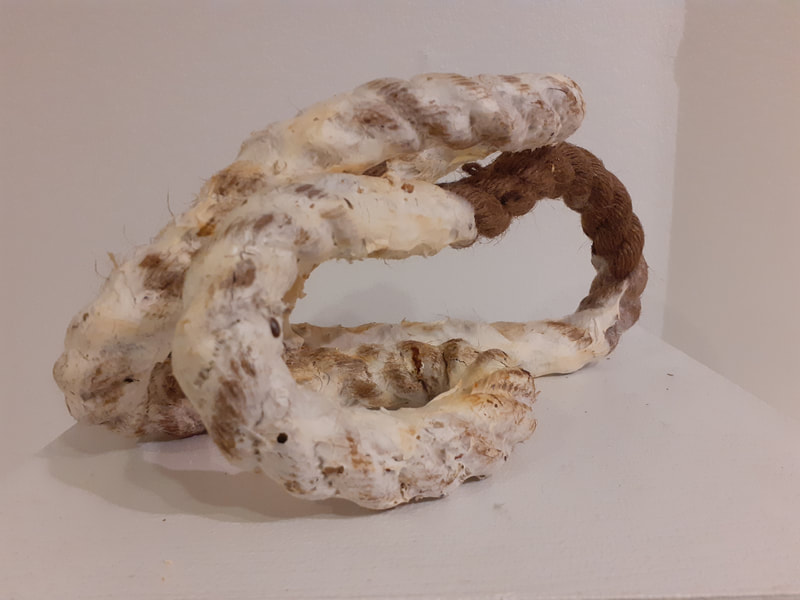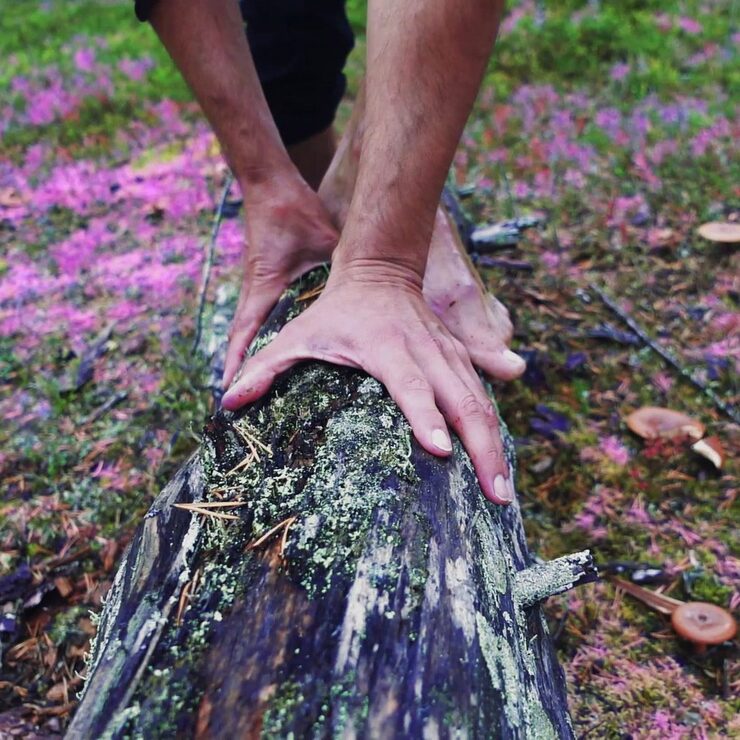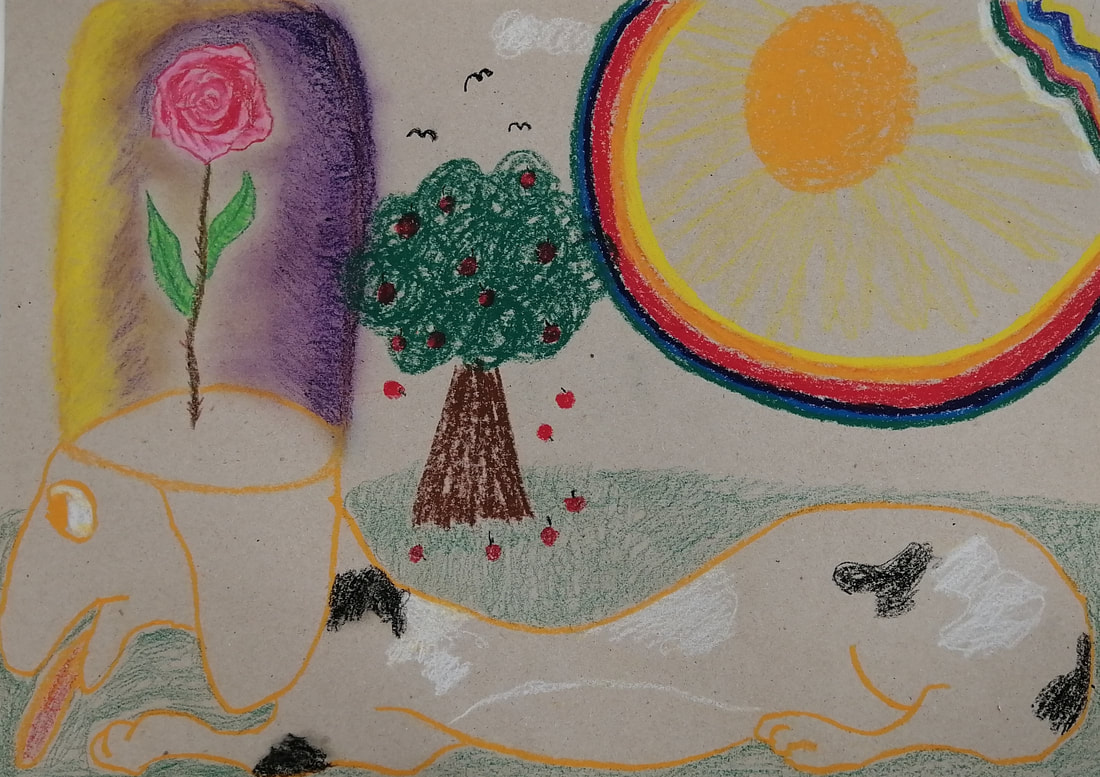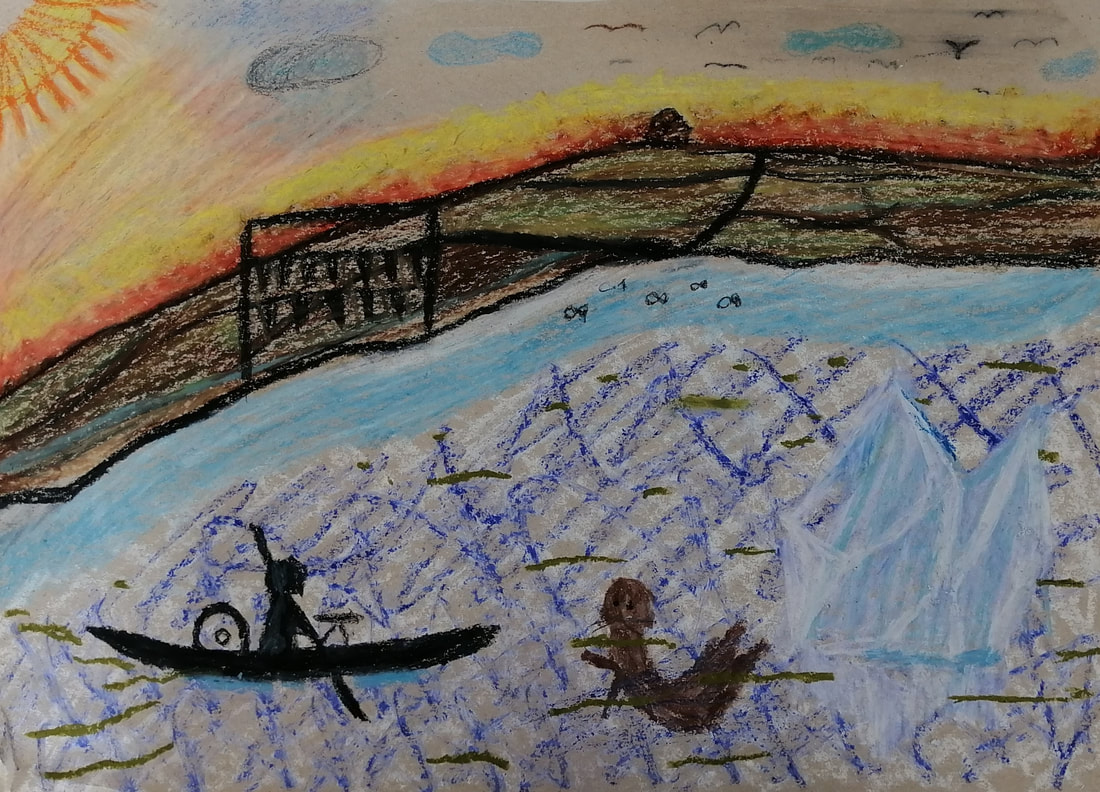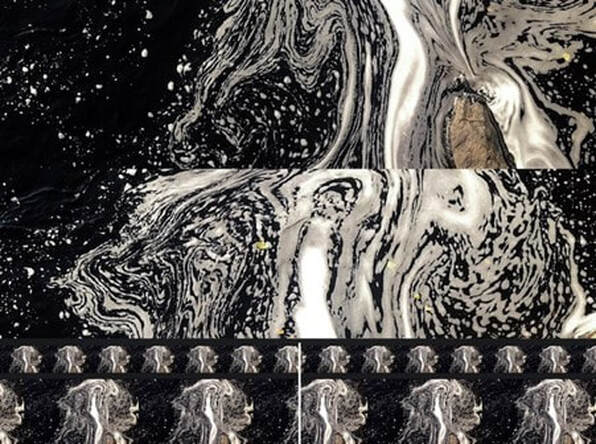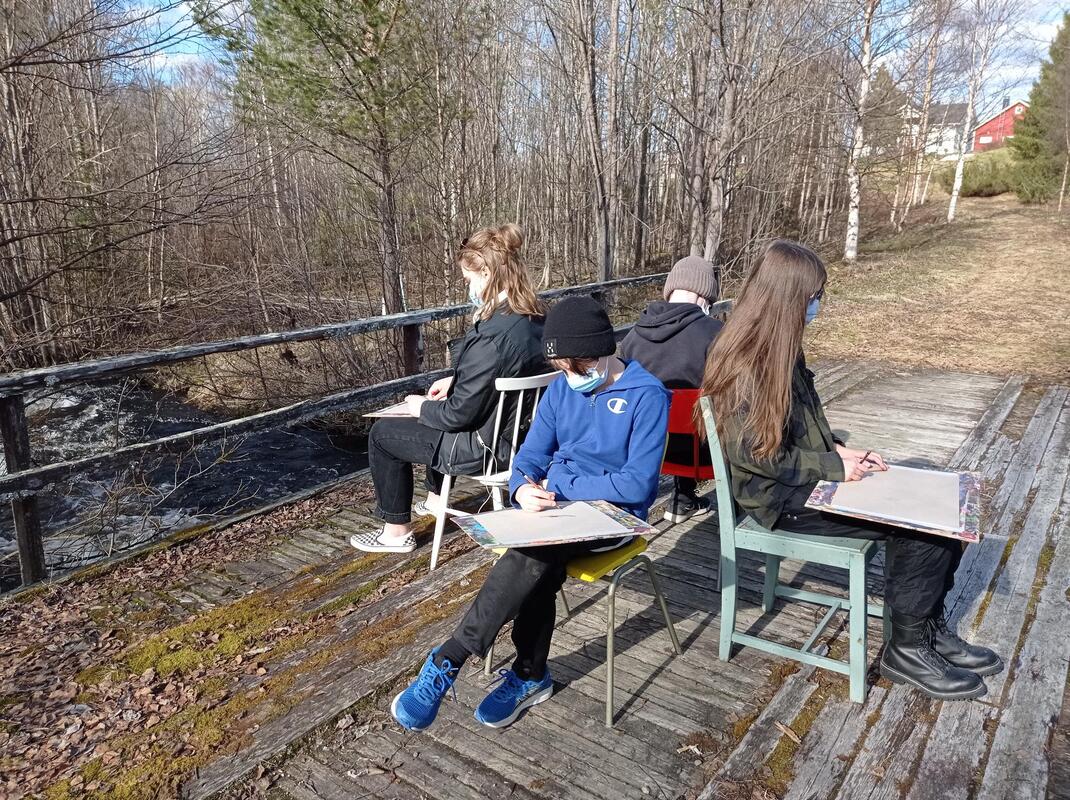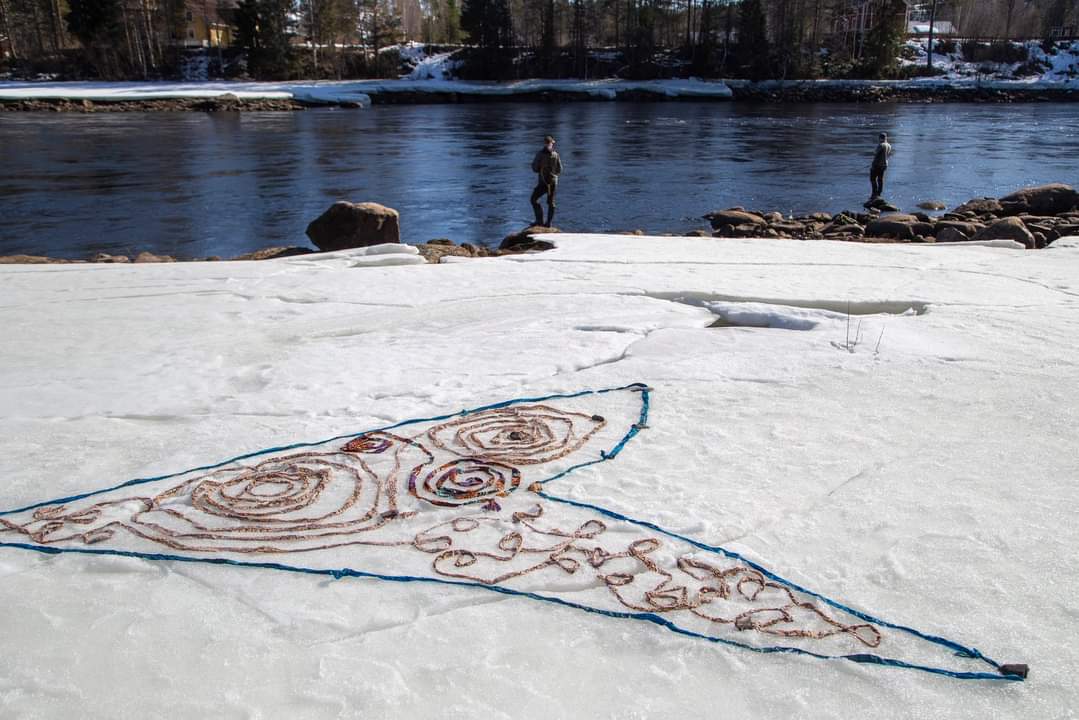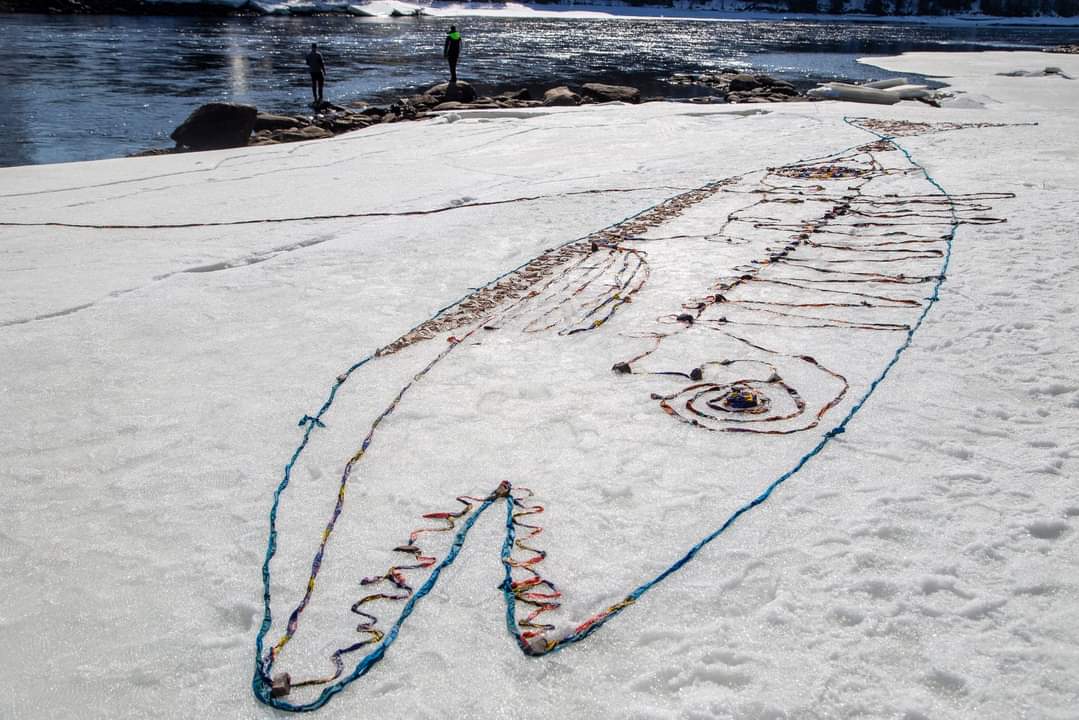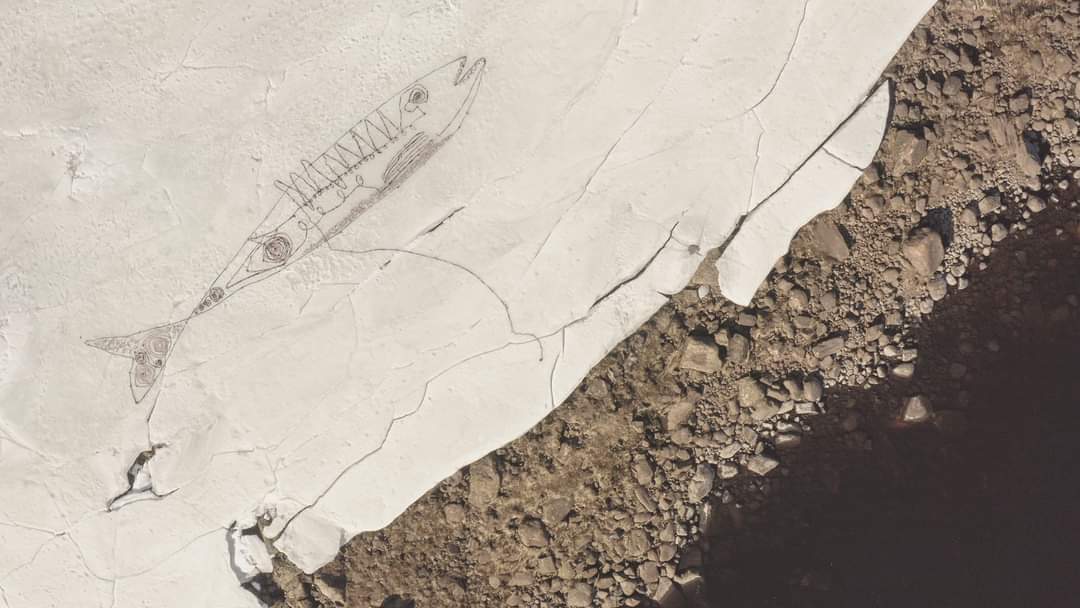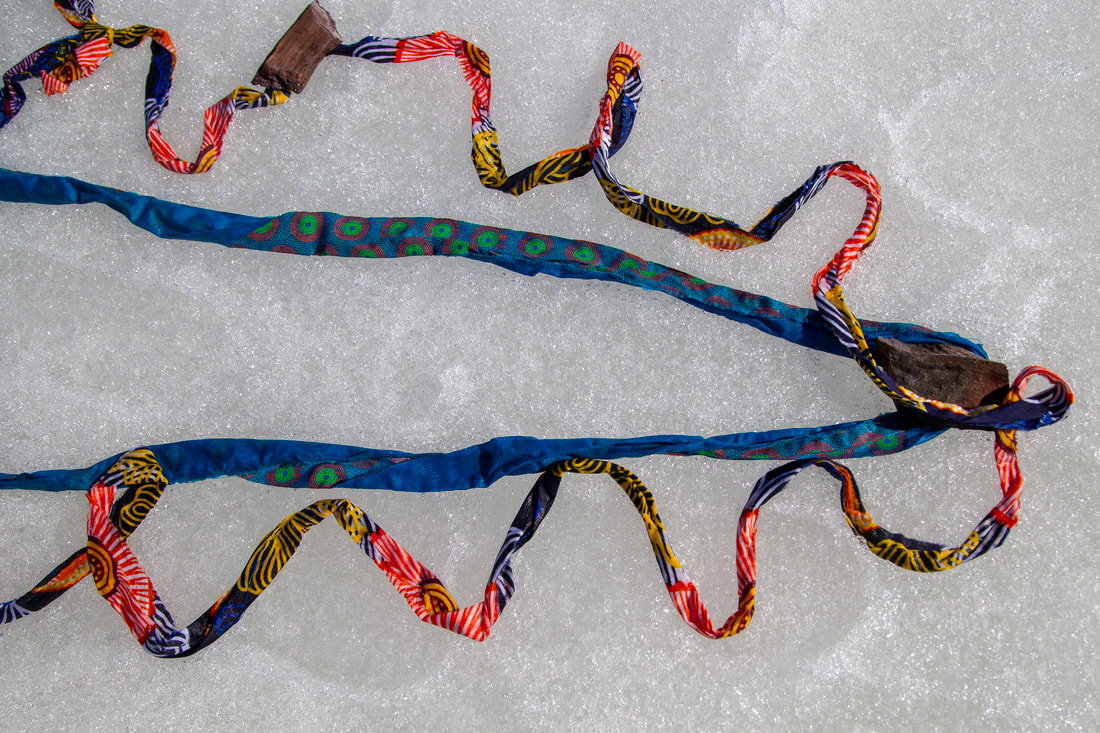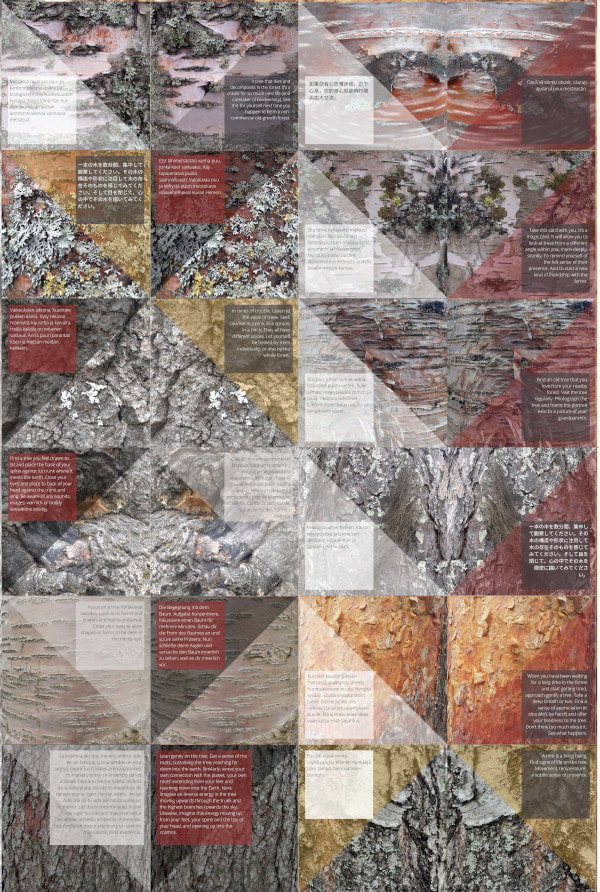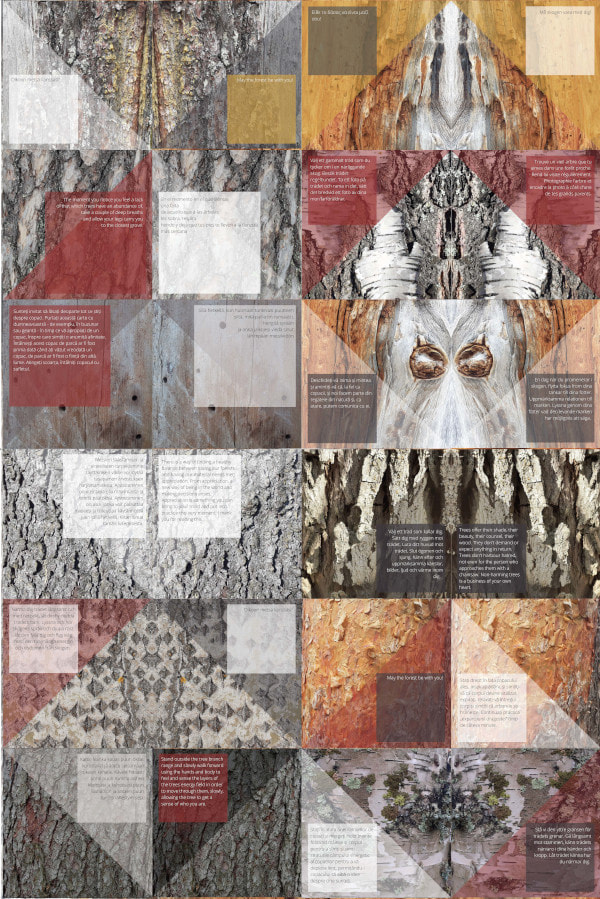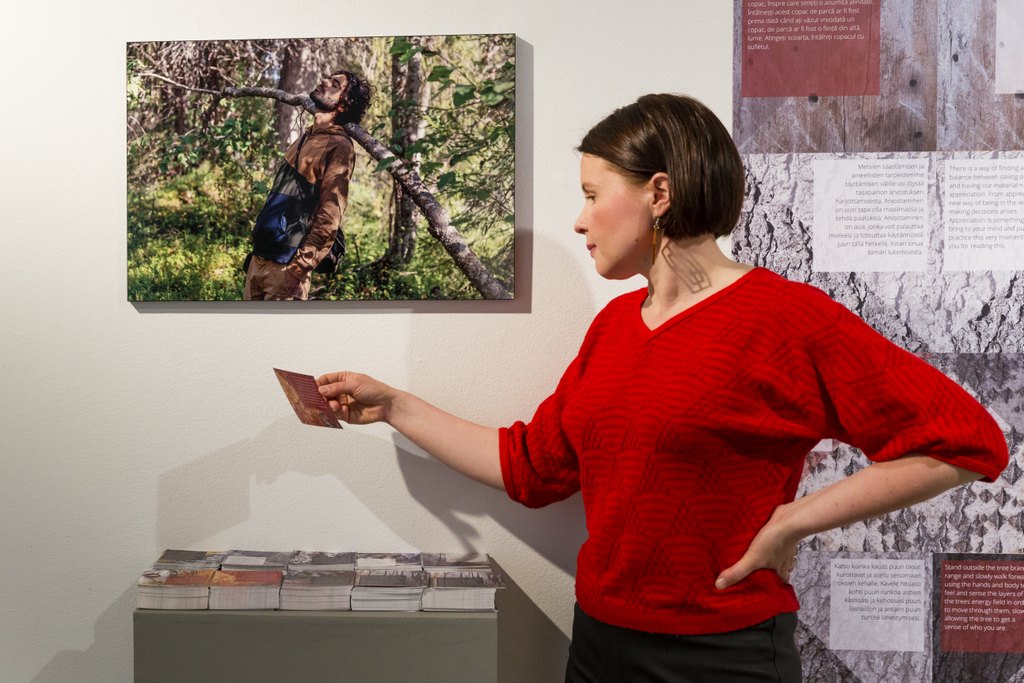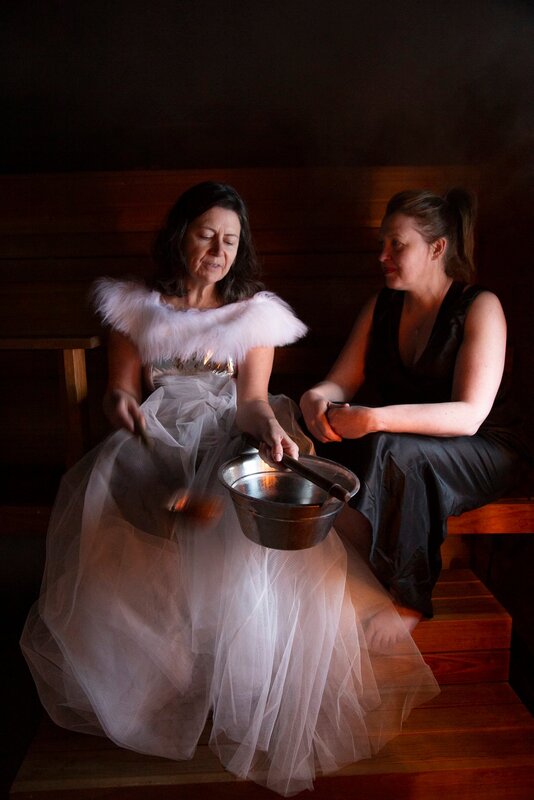SoftPowerArt
Amir Abdi, Maria Huhmarniemi, Taina Kontio, Satu Miettinen, Mari Mäkiranta, Heidi Pietarinen, Raisa Raekallio, Melanie Sarantou, Misha del Val
The SoftPowerArt experiment was carried out as part of the ‘Acting on the Margins: Arts as Social Sculpture’ research project through eight sub-projects executed by nine artists: Amir Abdi, Maria Huhmarniemi, Satu Miettinen, Taina Kontio, Raisa Raekallio, Misha del Val, Melanie Sarantou, Mari Mäkiranta and Heidi Pietarinen. The experiment tackled the role of the arts in expressing political and environmental viewpoints. Children and young people from the ages of 13–21 participated in two of the sub-projects, by Raisa Raekallio and Misha del Val. The participants engaged in mindfulness and shared artistic practices in remote locations of Kiittilӓ, Finland, and Ilulissat, Greenland. The remaining group of artists created a series of political and environmental artwork to tackle the diverse societal and environmental challenges in Finnish Lapland that would result in the further marginalisation of the people and communities in the area.
Reflections in water
Taina Kontio, Satu Miettinen
How can personal relationships between water, bodies and culture can be explored and narrated? This exploration involved artistic media such as costume design, performance, photography and video. Two artist-researchers and two performers were involved in the project, which was performed in Rovaniemi and on Vänö Island in the Baltic Sea. The aim of the research was to explore the role of agency and temporality in performance and the environment, to build bridges between our bodies and everything around them. The role of intergenerational connections in these matters is another temporal aspect that was considered. The methodology entailed reflexive research and collaborative visual analysis. The data were collected through narrative accounts of the events, and visual data were documented through photography and video.
Water is one of our most precious resources. It nurtures us physically, but it also carries and holds its consistency and flows through the stories and memories of our ancestral cultures, as it has done through many generations. In Finland, water and lakes have strong connections with national imagery and identity construction as well as folklore and natural mythologies related to fish and fishing as an important historical livelihood. Finland is often represented as the ‘country of a thousand lakes’, yet its water consumption may seem conspicuous by utilising overwhelming amounts of pure drinking water straight from household taps for everyday needs, from cooking to washing cars.
An artist-researcher engaged with performative, photographic and video art that explored the role of water in shaping intergenerational relationships and memories at several river and seascape sites across Finland. The context of rivers and the Baltic Sea archipelago creates a reference to water as an important and fragile resource in our ecosystem. Running water connects the different geographies of Finland from the Kemijoki in the Arctic to the Baltic Sea. The works eventually crossed paths in a collaborative and performative piece in Rovaniemi, in the water of the Kemi river. The photographic artist Satu Miettinen initiated and documented the performance and reinterpreted the media to embed her own intergenerational memories and connectedness with water within the video. The artistic collaboration was among the outcomes of an artistic residency programme for the protection of the Baltic Sea funded by the Association for Rural Culture and Education and the John Nurminen Foundation.
Water is one of our most precious resources. It nurtures us physically, but it also carries and holds its consistency and flows through the stories and memories of our ancestral cultures, as it has done through many generations. In Finland, water and lakes have strong connections with national imagery and identity construction as well as folklore and natural mythologies related to fish and fishing as an important historical livelihood. Finland is often represented as the ‘country of a thousand lakes’, yet its water consumption may seem conspicuous by utilising overwhelming amounts of pure drinking water straight from household taps for everyday needs, from cooking to washing cars.
An artist-researcher engaged with performative, photographic and video art that explored the role of water in shaping intergenerational relationships and memories at several river and seascape sites across Finland. The context of rivers and the Baltic Sea archipelago creates a reference to water as an important and fragile resource in our ecosystem. Running water connects the different geographies of Finland from the Kemijoki in the Arctic to the Baltic Sea. The works eventually crossed paths in a collaborative and performative piece in Rovaniemi, in the water of the Kemi river. The photographic artist Satu Miettinen initiated and documented the performance and reinterpreted the media to embed her own intergenerational memories and connectedness with water within the video. The artistic collaboration was among the outcomes of an artistic residency programme for the protection of the Baltic Sea funded by the Association for Rural Culture and Education and the John Nurminen Foundation.
Forest talks to us
Maria Huhmarniemi (as a curator)
Forest talks to us exhibition in the Gallery Kellokas, Äkäslompolo, Finland, 05/01/2021 - 17/02/2021.Photos: Maria Huhmarniemi
|
Video by Amir Abdi, 2021.
|
The ‘Forest Talks to Us’ group exhibition, curated by Maria Huhmarniemi as one of the SoftPowerArt experiments, offered perspectives on forest disputes and the concepts of conversation and co-creation. The theme of forest disputes comes from the pressing challenges of climate crises, lack of biodiversity and the forestry industry. Locals, nature activists, forest owners and representatives of national forest institutions each have different views about good forest use, and some argue that the forestry industry causes eco-anxiety. The need to increase dialogue and understanding of the cultural backgrounds of environmental conflicts is evident in Finnish Lapland. The artists of this group exhibition applied the arts for the mediation of environmental conflict by listening to and representing the various voices of stakeholders, including non-human nature and local cultures in Äkäslompolo. Ecoculture and forest culture were some of the key concepts in the exhibition.
|
Battle & Sense of Forest Conflict in Lapland
Maria Huhmarniemi
Maria Huhmarniemi, Battle. Part I of the series Sense of Forest Conflict, 2021, Installation: boxing gloves and stickers & Forest Culture. Part II of the series Sense of Forest Conflict, 2021, Installation: 8 knits, chains. Photo: Maria Huhmarniemi
Most Finns have an emotional relation to forest and strong opinions of the current state of the forest industry. Nature conservation organizations and some decision-makers call for the protection of biodiversity and carbon sinks. Industrial forest maintenance in the current form is not accepted by a large number of the Finns. The ongoing battle positions most of us to the audience. We follow the battle like a boxing match on television. Recent research indicates that Finns gain more well-being from mature forests than younger ones. Older forests have a sense of naturalness, aged trees and rich diversity. High pressure for the efficient forest industry and economic benefits violate our forest culture and discourage our renewal in forests.
Co-creation with nature
Amir Abdi
Amir Abdi, On the ropes: Bio-Art Yantra (Rope and Oyster mushroom), 2021, Photo: Maria Huhmarniemi (on the left and midle). Amir Abdi, still-image from the video “Synastry: Earth and Human”, 2021 (on the right)
Amir Abdi showed two artworks in the ‘Forest Talks to Us’ exhibition, ‘Synastry: Earth and Human’ and ‘On the ropes: Bio-Art Yantra’, both of which study human nature relations and co-creation. In the former, a video, Chilean Hugo Peña Lagos dances in a forest. The dance was edited into the soundscape by musician MycoLyco from electrical resistance measured by passing a small current through mushrooms. The changes in resistance were then converted into control signals that determined the rhythm, pitch, timbre and effects parameters on a modular synthesizer. Bio-Art Yantra consists of ropes and oyster mushrooms. The yantra was co-created by the artist with oyster fungus grown on ropes in a biolab with the help of mycologist Katarina Česnikin. The phrase in the title, ‘on the ropes’, refers to being at the edge of a conflict and the vulnerable position of being pinned against the ropes enclosing a boxing ring.
Mindfulness and Drawing Workshop
Misha del Val
The Mindfulness and Drawing workshop took place at a higher education institution in Ilulissat, Greenland, from Monday, April 12 to Friday, April 16, 2021. On average, 10–12 students attended the sessions during the week. The daily sessions were divided into 2 blocks of 1.5 hours each, with a break of 30 minutes in between. Three different spaces were used for the experiment: a classroom, meditation room (ample space where participants could sit or lie down on the floor) and art room (a space suited for artistic practices).
|
|
|
Day 5
Meditation Room The participants were offered a full set of guided mindfulness and loving kindness meditation. Art Room The group continued the collaborative drawing exercise that had begun the previous day for several more turns. The participants were asked to draw the front of a postcard that would be addressed to themselves. Classroom The teacher provided feedback for the writing/reflecting exercises done in the afternoons outside the hours of this workshop. During a brief visualisation exercise and writing a self-addressed postcard, the participants were asked to use their visualisation skills to revisit a place (room/environment) in which they had felt at ease and safe. From there, they were told to look through a window into the garden at things (people, objects, activities) that were important/valuable/meaningful to them and notice how they felt. They were also asked what they would say if they could whisper something now into the ear of their future selves. When they opened their eyes, the participants wrote to themselves on the postcard, which would be sent to them in 2 months’ time. The general feedback from the workshop was that its content was interesting and valuable, although language was a considerable barrier for many of the participants. It required a sort of concentration that detracted from the quality of attention and mental state that was being sought and encouraged. Some missed more physical movement. Many wrote, almost in the same words, ‘I have learnt a lot about myself.’ |
I Hear You in the River
Taina Kontio
I talk to the river, and the river answers me. It always has, even when I was very little. The river often talks about mundane things, saying ‘hello girl, I know who you are’, and it laughs and gives a hug before it hurries away. The river has all the knowledge of my past and my future: all the knowledge of the people gone; the nation lost. Forest Saami.
Interviews with Saami on placemaking and feminine space resulted in mind-blowing and important notions that there is part of the Saami nation, in the Forest Saami people, that has been forgotten and erased, and they need to be seen again. The arts would provide a way to do this. As this also touches on my family, I realised that that the remnants of Saami regalia that were with me on winter shoots of ethnographies were part of this. I feel this now very powerfully; my foremothers trying to talk.
I have started to hear the lost voice of the Korva/Koria/Pitkä Saami family, and I hope to find time to write about them. In the Kuusamo area, they were the ones who strongly opposed the Finns taking over Saami lands in 1600. Siegfried Ollis’s son, Korva Koria, moved to Kiiminki in 1700 and sowed many family traditions and left hidden information. I can see him talking to the river back then, leaving messages.
After this process with AMASS, I have found joy in my conversations with the spirits of the Forest Saami and their foremothers. They secretly lived underneath the streams and white waters and in the wind. There is tremendous joy in their present existence. I am so blessed that they know me and talk to me.
Interviews with Saami on placemaking and feminine space resulted in mind-blowing and important notions that there is part of the Saami nation, in the Forest Saami people, that has been forgotten and erased, and they need to be seen again. The arts would provide a way to do this. As this also touches on my family, I realised that that the remnants of Saami regalia that were with me on winter shoots of ethnographies were part of this. I feel this now very powerfully; my foremothers trying to talk.
I have started to hear the lost voice of the Korva/Koria/Pitkä Saami family, and I hope to find time to write about them. In the Kuusamo area, they were the ones who strongly opposed the Finns taking over Saami lands in 1600. Siegfried Ollis’s son, Korva Koria, moved to Kiiminki in 1700 and sowed many family traditions and left hidden information. I can see him talking to the river back then, leaving messages.
After this process with AMASS, I have found joy in my conversations with the spirits of the Forest Saami and their foremothers. They secretly lived underneath the streams and white waters and in the wind. There is tremendous joy in their present existence. I am so blessed that they know me and talk to me.
Kittilä Youngsters - A Little Art Experiment
Raisa Raekallio
|
This project brought together youngsters aged 13–16 in a small village in northern Finland and set out to find, through different art and meditation exercises, new ways of viewing the environment and gaining a new understanding of the familiar surroundings that we live in.
In the first workshop, we experimented with different kinds of drawing exercises, aiming to find new ways to approach and interpret our close environment. We observed how it would be to draw objects (e.g. stones, plants, man-made items) without seeing them, by focusing only on feeling. Encouraged to try not to recognise the object, the participants made a variety of drawings based only on the sensations in their hands. The aim was to disregard the pull of wanting to draw from the mind and classifying objects, and instead to work simply by using direct experience of the objects as a raw material. The participants did not draw a likeness of the objects; instead, they made different kinds of sketches, translating the sensations of features such as cold, slipperiness, softness or heaviness into the drawing. Another sensorial exercise was to draw sounds with closed eyes, putting pencil to paper while listening attentively to rapid classical music, techno music, or dogs barking. The group let the different sounds sink in and conveyed the ambience by making their unique impressions. |
In tree meditation, each participant chose a tree that they felt to be inviting. Each one was given a piece of clay and a letter, which they opened as they sat and leaned on the tree trunk. The letter had instructions on how to silence the mind and open up to experience the presence of the tree. Then everyone had an opportunity to listen to their tree and shape the possible message given by it into a piece of clay, with their eyes closed. The participants really took their time listening to the trees, and the connection seemed to work: the sculptures were beautiful, from abstract forms to the face of a creature. Afterwards, everyone left the sculptures next to their tree trunk, as a gift to the trees.
We also tried out different materials--paper, inks, crayons and pencils--and simply painted what we saw in the area. Homework was to pick a spot in a familiar everyday environment and draw or paint it: a landscape or detail of something considered beautiful, ugly or neutral. In the second workshop, we focused on just one task: painting in collaboration. A photograph was divided into 20 sectors, and each was distributed among the participants. Everyone painted their sector with watercolours on a large aquarelle paper that was also divided in 20 sectors. Together, the participants painted in their own style, with some of the sectors being almost abstract and others having a reference point from the environment they were in. The pictures were revealed one by one, so that the mystery of what had been painted continued for as long as possible. In the end, the small sectors formed a large landscape. One aim of this project was to bring together teenagers from a small village in northern Finland in a safe and relaxed atmosphere, where everyone could express themselves freely and simply do something different together. We also looked for mystery and magic in everyday life, in our own backyards. The participating kids turned out to be very artistic, and they clearly had their own vision and style for making art. The sessions had a meaningful undertone, and at the end of the second workshop, we made a plan to start meeting occasionally, just to draw and paint together. |
Five Salmon and Two Fish (viisi lohta ja kaksi kalaa)
Satu Miettinen, Taina Kontio, Melanie Sarantou and Mari Mäkiranta
Performance and a textile installation were the media used to help draw attention to human and sustainability issues relevant to the Kemijoki (Kemi River) and local communities of Finnish Lapland that live in proximity to and harmony with the river. The project explored the use of a place-specific installation on the banks of the Kemi as part of an artivist action entitled ‘Salmon War’, or lohisota. Artist-researchers Satu Miettinen, Taina Kontio, Mari Mäkiranta and Melanie Sarantou implemented this project in support of Professor Vesa Puuronen, who was fined €20,000 for leaving two pictures of salmon as graffiti, along with slogans, on private property owned by the Kemijoki Oy electricity company at Pirttikoski and Seitakorva. Puuronen had used the graffiti to protest against the newly proposed Sierilä power plant, to be built on the banks of the Kemi. The artist-researchers implemented the artivist action to raise awareness of the destruction of the indigenous salmon populations of the Kemi and to lobby for environmental action that could facilitate a return of indigenous fish populations in the river by, for example, providing or constructing bypasses for the salmon. In addition, the group aimed to raise awareness of the unprecedented and radical legal sanctioning of Puuronen for leaving graffiti on private property, as an artivist action.
The salmon, performance and craftism, needless to say, were very powerfull. Also, somehow a song of my forefathers was inside me, performing a ritual that had long been forgotten. Forest Saami, and my family of Korva/Pitkä Saami, lived very near to the area that I drove through that day. They had lost everything--their land and language and culture—and they are not even recognised any longer as Saami. I heard their voice--I know I am their voice, which is almost silent. (Kontio, age 60, 2021)
While this activity was implemented in Finnish Lapland, another was taking place in the remote far west coast of South Australia. Both performances aimed to raise awareness of the environmental harm being caused by capitalist-driven energy producing companies. In Rovaniemi, the capital of Finnish Lapland, the artivist action addressed the disappearance of indigenous salmon from the Kemi River due to the unsustainable activities of an electricity company, while in South Australia, the artivism was performed at the Wittelbee National Conservancy in the outback town of Ceduna. The latter was to drive a strong environmental message against the drilling for oil in the Great Australian Bight, which will intrude on and disrupts the breeding of more than 10% of the global population of southern right whales.
Encounter-a-tree
Maria Huhmarniemi
co-artists Francis Joy, Misha del Val, Hugo Peña, Amir Abdi, Tanja Koistinen, Raisa Raekallio and Smaranda Moldovan
Maria Huhmarniemi and co-artists Francis Joy, Misha del Val, Hugo Peña, Amir Abdi, Tanja Koistinen, Raisa Raekallio and Smaranda Moldovan. Encounter-a-tree, 2021, Participatory installation (posters on the wall, sharable cards, Instagram @encounteratree), 1782mm X 5940 mm.
In Finland’s Rovaniemi city, cut-down trees have caused sorrow and vibrant discussion among residents. While some of the people see mature trees as old friends, for others they are potential safety risks or just worthless. Consequently, trees that people feel connected to have been lost. At the same time researchers report a growing number of depressed and lonely people in Finland, worsened by the Coronavirus pandemic. Part of the population is depressed by eco-anxiety. The Encounter-a-tree installation presents a number of guidelines for humans to encounter trees and open up their senses in a forest. The guidelines were given by Huhmarniemi and other artists who had experiences connection with trees. The installation is participatory and it can be followed also as Instagram art.
Sauna Stories
Melanie Sarantou, Satu Miettinen, Heidi Pietarinen
|
Traditional Finnish saunas are different for women compared to those for men, mainly due to the many transitions in the lives of women that influence the diverse activities that women undertake in the space of healing, nursing, cleansing, resting and even dreaming. Performance and photo documentary activity took place within the space of such a sauna in northern Lapland, specifically a wooden heated sauna in the Keropirtti, a large log cabin that was built in the 1950s near Pyhä Tunturi (Holy Peak). There, the research team of the University of Lapland addressed the social anxieties associated with climate change, especially in the frail environment of the Arctic and Finnish Lapland, which is also the homeland of the indigenous Sámi peoples and provides their livelihood. The perfomance took place on a cold day with outside temparatures dropping to minus 24 degrees. We, the creators, had planned to capture photographic documentation of a performance in the snow and natural environment of Pyhä, but the cold weather kept us inside. For practical reasons, as the space was cosy and warm, artist-researcher Satu Miettinen conducted experimental photography in the sauna when the idea emerged that the space could be used for documenting the performance. Miettinen was attracted to the soft light and ambience that enabled her to capture a specific phtographic quality based on contrasts created by the warm light of the fireplace. Artist-researchers Heidi Pietarinen and Melanie Sarantou executed the performance while wearing garments that may (not) be considered fashionable. One garment was created by Sarantou partly from recycled materials such as silver foil from commercial water bladders and white tulle. The other, worn by Pietarinen, was a classic black re-used formal dress. It was an unusual choice to wear such fashion due to the Finnish tradition that no clothing, or at least only natural fibres, especially linen, cotton and wool, should be worn in a sauna.
|
Experiments in sauna from Satu Miettinen on Vimeo.
Publications
And exhibitions where the experiment has been shown
Huhmarniemi, M. (2021). Forest talks to us – art and coping with forest disputes. ART Education VISUAL Journal IMAG. https://doi.org/10.24981/2414-3332-11.2021
Huhmarniemi, M. (2021). Arctic craftivism and revitalisation of crafting. INVISIBILIDADES. Ibero-American Journal of Research in Education, Culture and Arts, (15), 54–63. https://doi.org/10.24981/16470508.15.6
Huhmarniemi, M. (2021). Yhteisön laajentaminen taidekasvatuksen ja yhteisötaiteen keinoin. [Expanding community through art education and community art]. Research in Arts and Education, 2021(3), 151–166, https://researtsedu.com/2021-september-3
Huhmarniemi, M. (Forthcoming). Participatory art with trees: pedagogical approach. In R. Vella & V. Pavlou (Eds.), Art, Sustainaibility and Learning Communities: Call to Action. Intellect.
Miettinen, S., & Sarantou, M. (2021). Five salmon and two fish (viisi lohta ja kaksi kalaa). In R. Vella & M. Sarantou (Eds.), Documents of socially engaged art (pp. 36–46). Insea Publications.
Sarantou, M., Miettinen, S. & Pietarinen, H. (2021). Documenting Sauna Stories: Naked Narratives on Fashion and Culture. In R. Vella & S. Sarantou, M. (Eds.), Documents of Socially Engaged Art (pp. 76–91). InSEA Publications.
Exhibitions
Documents of Socially Engaged Art. Saint James Cavalier, Spazju Kreattiv, Malta, 2021.
ISEAS: Conversation, Rovaniemi Art Museum, Rovaniemi, Finland, 2021.
Forest Talks to us, Gallery Kellokas, Äkäslompolo, Finland, 2021.
Huhmarniemi, M. (2021). Arctic craftivism and revitalisation of crafting. INVISIBILIDADES. Ibero-American Journal of Research in Education, Culture and Arts, (15), 54–63. https://doi.org/10.24981/16470508.15.6
Huhmarniemi, M. (2021). Yhteisön laajentaminen taidekasvatuksen ja yhteisötaiteen keinoin. [Expanding community through art education and community art]. Research in Arts and Education, 2021(3), 151–166, https://researtsedu.com/2021-september-3
Huhmarniemi, M. (Forthcoming). Participatory art with trees: pedagogical approach. In R. Vella & V. Pavlou (Eds.), Art, Sustainaibility and Learning Communities: Call to Action. Intellect.
Miettinen, S., & Sarantou, M. (2021). Five salmon and two fish (viisi lohta ja kaksi kalaa). In R. Vella & M. Sarantou (Eds.), Documents of socially engaged art (pp. 36–46). Insea Publications.
Sarantou, M., Miettinen, S. & Pietarinen, H. (2021). Documenting Sauna Stories: Naked Narratives on Fashion and Culture. In R. Vella & S. Sarantou, M. (Eds.), Documents of Socially Engaged Art (pp. 76–91). InSEA Publications.
Exhibitions
Documents of Socially Engaged Art. Saint James Cavalier, Spazju Kreattiv, Malta, 2021.
ISEAS: Conversation, Rovaniemi Art Museum, Rovaniemi, Finland, 2021.
Forest Talks to us, Gallery Kellokas, Äkäslompolo, Finland, 2021.
